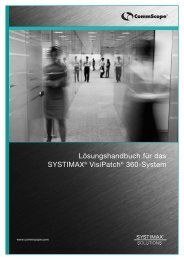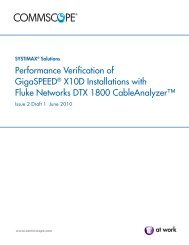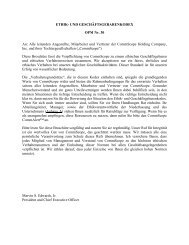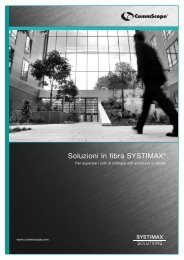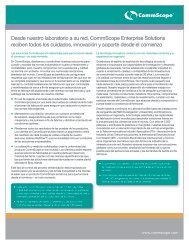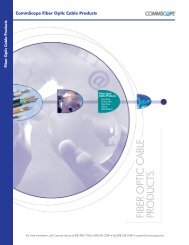Broadband Applications & Construction Manual - Public - CommScope
Broadband Applications & Construction Manual - Public - CommScope
Broadband Applications & Construction Manual - Public - CommScope
Create successful ePaper yourself
Turn your PDF publications into a flip-book with our unique Google optimized e-Paper software.
2.2 Cable Descriptions<br />
The Importance of Braid Shielding<br />
Braid Shielding and Coaxial Cable Performance<br />
A coaxial cable must have, at minimum, a dual shield of aluminum foil tape overlaid with a woven braid of aluminum.<br />
This braid shield greatly improves the electrical and mechanical performance of the coax;<br />
in fact, a braid shield can vastly increase the installed life of the cable. All <strong>CommScope</strong> subscriber access coaxial<br />
cables use a combination of foil and braid shields.<br />
Braid Shielding Provides Low Frequency Protection<br />
Foil shielding is usually a layer of aluminum bonded to a polyester tape. It provides<br />
100% coverage over the dielectric and is best at preventing ingress and leakage of<br />
high frequency signals; however, it is not that effective with lower frequency signals.<br />
Aluminum braid shielding complements foil by containing and preventing interference<br />
from those lower frequencies.<br />
Braid shields<br />
increase cable<br />
performance<br />
and can<br />
greatly extend<br />
the useful life<br />
of the cable<br />
Braid Shielding Helps Maintain DC Resistance<br />
Foil shielding is very flexible but lacking in mechanical strength. Stress caused by installation or by twisting and<br />
flexing over time (like in an aerial installation) will cause microscopic gaps to open in the foil. These ‘microcracks’<br />
degrade the electrical integrity of the foil and cause the DC resistance of the cable to rise. Resistivity gets worse as<br />
the cable twists.<br />
Strong, flexible braid shielding supports the foil and helps fight the formation of microcracks. The braid wires do<br />
not microcrack; they bridge the gaps in the foil. Braid shielding keeps its integrity and delivers low and constant<br />
resistivity numbers even when twisting and flexing.<br />
Braid Shielding Keeps Attenuation Low<br />
Attenuation performance goes hand in hand with DC resistivity; high resistivity caused by microcracks in the foil will<br />
result in higher attenuation. A history of 15,000 flexures can degrade a foil shield to the point where the calculated<br />
attenuation could worsen by 400% or more. However, the robust nature of the additional braid shield keeps attenuation<br />
low.<br />
Braid Shielding Keeps Connectors Connected<br />
The additional strength provided by braid shielding gives connectors something to hold onto. In terms of pulloff<br />
force, both compression and crimp-fitted connectors hold much tighter to cables with braid shields.



